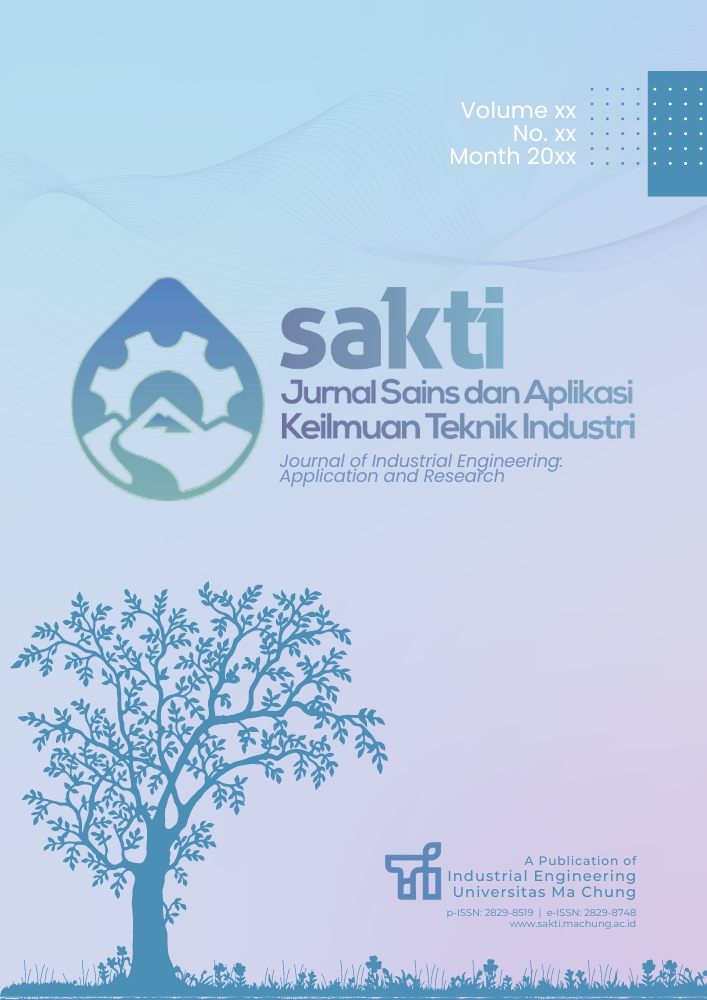Cycle Time Study in Improving Production Output in the Garment Industry Sewing Line
DOI:
https://doi.org/10.33479/sakti.v4i1.91Keywords:
Cycle time, Fishbone diagram, Five whys analysis, Garment industry, Production outputAbstract
The garment industry is one of the fastest-paced production environments, where speed and accuracy are crucial for meeting global customer demand. Cycle time plays an important role in satisfying the speed factor as it represents the overall time needed to produce a single piece of a product. Maintaining an appropriate cycle time is key to achieving production line balance. This study aims to analyze the cycle time of men's jacket production on a sewing line in an Indonesian garment industry by comparing the actual cycle time with the standard cycle time based on the operation breakdown for each production process step. Four significant discrepancies in actual cycle time were identified, ranging from 16% to 95%, indicating that the actual cycle time was significantly longer than the standard cycle time. The root cause of the highest cycle time was analyzed using Fishbone and 5 Whys analysis to understand the problem from each factor and sub-factor. Six improvement action plans were proposed and implemented, resulting in a 57.81% reduction in actual cycle time, from 127.66 seconds to 53.85 seconds, making it 17.66% faster than the standard cycle time. Furthermore, the total output per hour increased by approximately 216.67%, from 12 pieces to 38 pieces. This result implies that the study successfully identified the root of the problem on the sewing line and managed to increase production output.
References
Afifuddin, M. (2020). Analisis Penyebab Ketidakrataan Sliver Carding pada Mesin Carding JWF 1204 di Departemen 5 PT Sri Rejeki Isman Tbk. Jurnal Tekstil: Jurnal Keilmuan dan Aplikasi Bidang Tekstil dan Manajemen Industri, 3(1), 8-14.
Alam, A. C., Mustakim, & Tjahjaningsih, Y.S. (2022). Analisa Keseimbangan Lintasan Dalam Meningkatkan Produksi di PT. Eratex Djaja Tbk. Probolinggo. Journal of Industrial System Engineering (JISE) Vol. 1, No. 2, pp. 72-79.
Cao H, & Ji X. (2021). Prediction of Garment Production Cycle Time Based on a Neural Network. FIBRES & TEXTILES in Eastern Europe; 29, 1(145): 8-12. DOI: 10.5604/01.3001.0014.5036.
Jadhav, G.S.Sharma, Daberao A.M, & Gulhane S.S. (2017). Improving Productivity of Garment Industry with Time Study. International Journal on Textile Engineering and Processes. ISSN 2395-3578 Vol. 3, Issue October 2017.
Kasanah, Y. U., & Suryadhini, P. P. (2021). Identifikasi Pemborosan Aktivitas di Lantai Produksi PSR Menggunakan Process Activity Mapping Dan Waste Assessment Model. Jurnal INTECH Teknik Industri Universitas Serang Raya, 7(2), 95-102.
Khairunnisa, H., Toat, A., Darmawi, A., & Ardiyanto, A. (2022). Manufacturing Losses Analysis of Ring Spinning Machine Based on Overall Equipment Effectiveness Evaluation: A Textile Case Study. In Proceedings of the International Manufacturing Engineering Conference & The Asia Pacific Conference on Manufacturing Systems (pp. 339-348). Singapore: Springer Nature Singapore.
Kurnianingtias, M., Heryadi, A.R., Purwanningrum, D., Astrini, G.Y., Khairunnisa, H., & Sari, L.N.I. (2021). Analisis Penyelesaian Permasalahan Bottleneck pada Lini Produksi di Pabrik Tekstil dengan Metode Kaizen. Jurnal REKAVASI, Vol. 9, No. 2, Desember2021, 23-30.
Kurnianingtias, M., Sormin, Y. S. A., & Dianijati, H. A. (2022). Analisis Permasalahan Press Mark pada Celana Olahraga Wanita bagian Front Side Body. Jurnal Tekstil: Jurnal Keilmuan dan Aplikasi Bidang Tekstil dan Manajemen Industri, 5(1), 54-60.
Larasati, P.D., & Laksono, P.W. (2022). Implementasi Lean Manufacturing untuk Mempersingkat Lead Time di PT XYZ dengan Metode Value Stream Mapping. Seminar dan Konferensi Nasional IDEC 2022 23 Juli 2022 ISSN: 2579-6429.
Neyestani, B. (2017). Seven basic tools of quality control: The appropriate techniques for solving quality problems in the organizations. SSRN Electronic Journal, 1–10. https://doi.org/10.2139/ssrn.2955721
Oktyajati, N., Mayasari, S., & Purwati, S. (2023). Implementasi Sistem One Piece Flow untuk Mengurangi Lead Time Produksi pada Industri Garmen. Jurnal Ilmiah Teknik Industri dan Informasi Vol. 12 – No. 1. DOI: https://doi.org/10.31001/tekinfo.v12i1.2185 E-ISSN: 2303-1867 | P-ISSN: 2303-1476.
Yudhistira, G.A., Hidayah, R.N., Rahajeng, D.P., Perdana, A.H., & Basumerda, C. (2022). Analisis Waktu Kerja dengan Metode Stopwatch pada Industri Garmen. Seminar dan Konferensi Nasional IDEC 2022 ISSN: 2579-6429.









